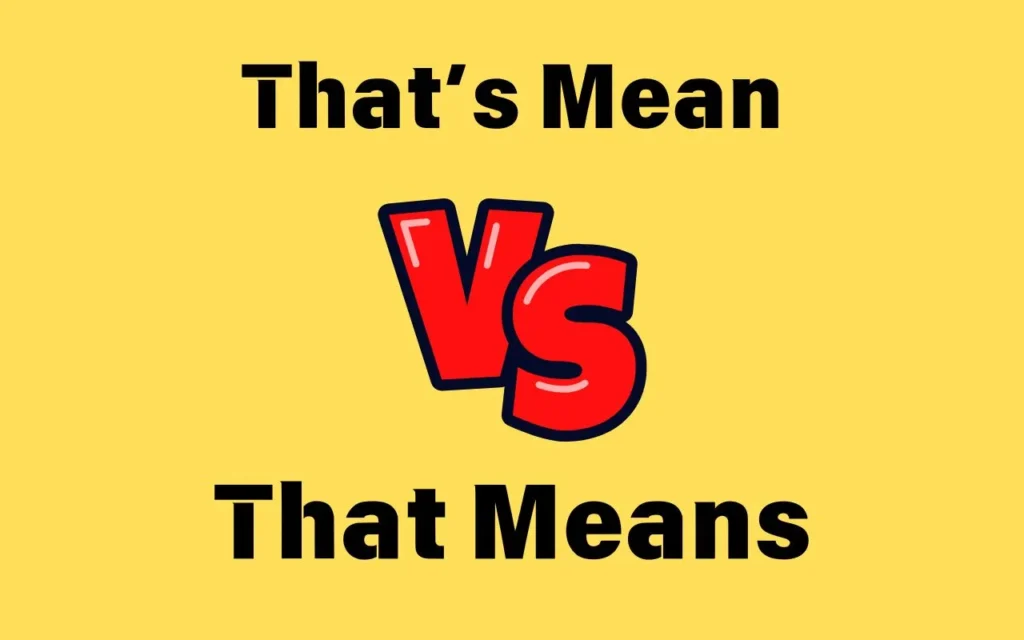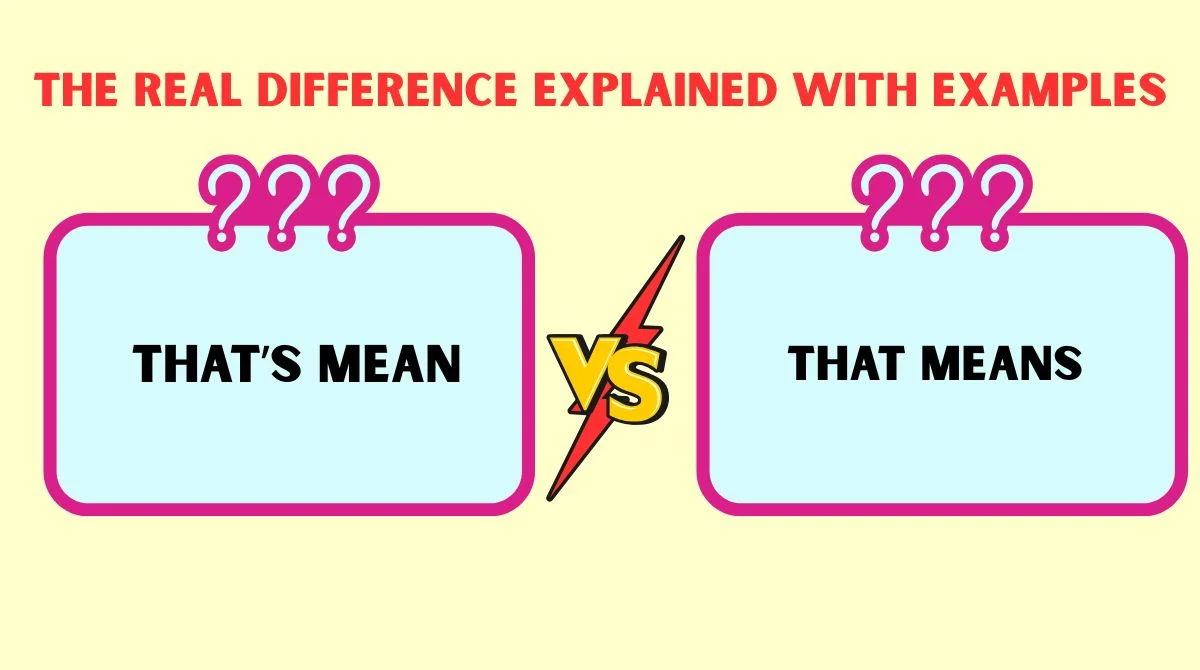Last updated on September 26th, 2025 at 01:53 pm
English can be tricky. Two short phrases like “That’s mean” and “That means” look almost identical, but they carry completely different ideas.
Learners often stumble over them because the only visible difference is one tiny word — mean versus means. Yet, this subtle change flips the meaning entirely.
This guide dives deep into their definitions, usage, grammar, pronunciation, common mistakes, and practical tips. By the end, you’ll know exactly when to use “That’s mean” and when to use “That means.”
Understanding the Core Difference

At first glance, both phrases begin the same way: “That’s…” But what follows changes everything.
- That’s mean → a reaction to someone’s behavior. It shows disapproval, usually describing something as unkind, unfair, or harsh.
- That means → an explanation or logical consequence. It introduces clarification, results, or interpretations.
Here’s a quick comparison to make it crystal clear:
| Phrase | Function | Example Sentence |
|---|---|---|
| That’s mean | Expresses judgment (unkind, rude, unfair) | “You pushed him? That’s mean.” |
| That means | Explains a result or conclusion | “It’s raining. That means we need umbrellas.” |
Think of it this way: “That’s mean” talks about people. “That means” talks about situations.
Deep Dive: What Does “That’s Mean” Mean?
The word mean in this phrase is an adjective. It describes something cruel, nasty, or hurtful. When you say “That’s mean,” you’re labeling an action or statement as unkind.
Emotional and Social Context
- Used when judging behavior:
- “You didn’t share your food? That’s mean.”
- Expresses empathy for someone else:
- “You ignored her message? That’s mean.”
Positive or Sarcastic Uses
In informal slang, especially among friends, “mean” can sometimes mean impressive or awesome. For example:
- “He plays a mean guitar.” (meaning: very skilled)
- “Ooh, that’s mean!” (playful, joking, not literal cruelty)
This makes context vital. Tone, body language, and situation determine whether it’s negative or playful.
Common Situations for “That’s Mean”
- Bullying or teasing → “He called you names? That’s mean.”
- Unfairness → “She got punished for nothing? That’s mean.”
- Joking among friends → “You took the last cookie? That’s mean!”
In every case, it reacts to an action or choice, not an explanation.
Deep Dive: What Does “That Means” Mean?
Here, means is a verb, not an adjective. It comes from the verb to mean, which expresses purpose, explanation, or implication.
Definition and Usage
- Used to clarify or interpret something.
- Connects facts with conclusions.
Examples:
- “I passed the exam. That means I’ll graduate.”
- “The light is red. That means you must stop.”
Everyday Functions of “That Means”
- Explanation:
- “You missed the bus. That means you’ll be late.”
- Consequence:
- “We won the game! That means we’re in the finals.”
- Instruction:
- “It’s locked. That means you need a key.”
Signal Words That Often Follow
After “That means,” you’ll often see pronouns and modal verbs like:
- I/you/we + have to/should/must…
- It’s clear that…
- Therefore…
For example:
- “It’s raining. That means we should stay inside.”
- “He got the promotion. That means he’s the new manager.”
Pronunciation and Grammar Notes
Even though both phrases start with “That’s” (contraction of “That is”), their grammar paths split after the contraction.
- That’s mean → That is + adjective (mean = unkind).
- That means → That + verb (means = explains or implies).
Pronunciation
- That’s mean → /ðæts miːn/
- That means → /ðæt miːnz/
The subtle difference lies in the ending sound:
- /n/ for “mean”
- /nz/ for “means”
A native speaker may blend them quickly, but careful listening reveals the difference.
Examples in Real Sentences
Seeing phrases in context is the fastest way to understand.
“That’s Mean” Examples
- “You told her secret? That’s mean.”
- “Don’t laugh at his accent. That’s mean.”
- “You left without me? That’s mean!”
“That Means” Examples
- “We got a flat tire. That means we’ll be late.”
- “It’s the last day of the sale. That means everything is cheaper.”
- “She didn’t answer. That means she’s busy.”
Notice how “That’s mean” judges people, while “That means” explains situations.
Related and Confusing Phrases
Sometimes learners confuse similar phrases. Here are useful alternatives:
Alternatives to “That’s Mean”
- That’s rude
- That’s cruel
- That’s unfair
- That’s harsh
- That’s nasty
Alternatives to “That Means”
- That implies
- That indicates
- That suggests
- That shows
- Therefore
Quick comparison:
| Instead of “That’s mean” | Instead of “That means” |
|---|---|
| “That’s rude.” | “That suggests…” |
| “That’s unfair.” | “That indicates…” |
| “That’s harsh.” | “That shows…” |
Common Mistakes Learners Make
Because both phrases look and sound nearly identical, English learners often swap them accidentally.
Frequent Errors
- Saying “That’s mean” when they want to explain something:
- Wrong: “He’s late. That’s mean he’s coming soon.”
- Correct: “He’s late. That means he’s stuck in traffic.”
- Using “That means” when judging someone:
- Wrong: “You hit her? That means.”
- Correct: “You hit her? That’s mean.”
Why Mistakes Happen
- Both share That’s/That at the start.
- Non-native speakers may not hear the subtle /n/ vs /nz/ sound difference.
- The word “mean” also has multiple definitions (unkind, average, mathematical mean).
Practical Usage Tips
When in doubt, follow this quick guide:
- Talking about behavior or personality? → Use That’s mean.
- Explaining a situation or result? → Use That means.
Quick Decision Checklist
- Is it about kindness or rudeness? → That’s mean.
- Is it about explanation or consequence? → That means.
Mnemonic Device
- “Mean = Mean people.” (Judging behavior)
- “Means = Meaning.” (Explaining result)
Case Study: Real-Life Conversation Example
Imagine two friends talking:
Scenario 1 – Using “That’s mean”
- Alex: “I told John his shoes looked funny.”
- Mia: “Wow, that’s mean. He probably felt bad.”
Scenario 2 – Using “That Means”
- Alex: “The teacher canceled class today.”
- Mia: “That means we can leave early.”
Same starter phrase, different functions. This shows why paying attention to context is crucial.
🙋 FAQs
What does “That’s mean” mean?
That’s mean describes behavior that is unkind, rude, or unfair, often used to show disapproval.
What does “That means” mean?
That means is used to explain or clarify a result, consequence, or implication of something.
How do I know when to use “That’s mean” vs “That means”?
Use That’s mean when judging someone’s behavior and That means when explaining a situation or result.
Is “That’s mean” always negative?
Not always. In slang, it can be playful or even positive, like “He plays a mean guitar,” meaning very skilled.
What are alternatives to “That means”?
You can say that implies, that suggests, that indicates, or that shows instead of “That means.”
Why do learners confuse “That’s mean” and “That means”?
Both sound very similar, but the difference lies in meaning: mean (adjective for behavior) vs means (verb for explanation).
Conclusion
The confusion between “That’s mean” and “That means” is completely normal, especially for learners. But the difference is simple once you break it down:
- That’s mean → Describes behavior as unkind, unfair, or rude.
- That means → Explains a result, implication, or conclusion.
By practicing with real examples, listening closely to pronunciation, and remembering the people vs situation trick, you’ll never mix them up again. Next time you’re about to say one of these phrases, stop and ask yourself: Am I judging behavior or explaining a result? The answer will guide you to the correct choice.
